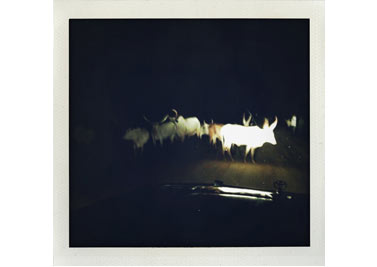Avoiding the simplistic narratives of Afro-pessimism and Afro-optimism, photographer Peter diCampo uses photo-apps to represent everyday Africa.
A Ugandan woman hangs freshly laundered sheets out to dry. Her pink dress is taut over her pregnant belly. The blue bucket she used to wash the sheets sits beside her in the sun. This commonplace task feels even more familiar captured in the soft color palette of a Hipstamatic iPhone app. Photographer Peter diCampo shot this image earlier this year while working on other ongoing documentary projects, but this image is very different from his photojournalism work.
In an interview, diCampo said that his choice of tool for this photo is remarkable not because he’s the first photojournalist to take photos with an iPhone—he certainly isn’t—but because he’s using it in an attempt to redefine the way the West sees Africa. His project, Everyday Africa, which includes many but not all of the images featured above, is a collection of iPhone photos taken by a group of photographers working throughout the continent.
The dominant 1990s narrative of Afro-pessimism—famine! war! strife!—is currently being swapped out for an equally simplistic narrative of Afro-optimism—mobile phones! emerging markets! Chinese investment! Ultimately, Afro-pessimism and Afro-optimism are both predetermined narratives with pat conclusions. Some critics of the old pessimism now claim that media coverage of Africa is getting better. But what does better media coverage of Africa mean? With a proliferation of different types of images, perhaps we can look past simple conclusions and find a more complicated narrative that leaves space for simple moments, like a woman doing laundry.
When Facebook bought Instagram, a company with no actual revenue, for a billion dollars, it was an indicator of the value attributed to the picture of a meal at brunch, brooding storm clouds, a girlfriend’s smile, a co-worker’s kids.
We’ve all seen these images: shot on mobile devices, altered with a series of nostalgic filters and shared instantly with our networks.
These incredibly popular apps, with as many as five million new users per week, have been vehemently opposed by some in mainstream photojournalism and embraced by others.
Perhaps the iPhone does trivialize—but in the case of contentious representations of everyday Africa, this is not its weakness but its strength. And for all the reasons that the iPhone fails at traditional photojournalism, perhaps it’s the most radical approach we can use to rethink the way we represent Africa.
Those arguing against using iPhones for photojournalism say that they trivialize the subject matter, that the level of digital manipulation is unacceptable for a medium that is supposed to document “truth,” and that it turns the photojournalistic reins over to the masses.
“Using InstaHip trivializes the message when used in a photojournalistic context … People might now care a little more about Libya, but they care about it as much as they care about their breakfast,” writes prominent photography blogger and critic Jörg Colberg.
Perhaps the iPhone does trivialize—but in the case of contentious representations of everyday Africa, this is not its weakness but its strength. And for all the reasons that the iPhone fails at traditional photojournalism, perhaps it’s the most radical approach we can use to rethink the way we represent Africa.
The iPhone’s shortcomings as a tool of photojournalism might be its strength in a battle against stereotypes
Using the iPhone to photograph Africa takes the political act of representing a place whose “otherness” usually allows it to be a repository for our stereotyped narratives and instead renders them in the same color palette as yesterday’s summer afternoon BBQ.
We have so many ideas about what Africa looks like. Using an iPhone circumvents these preconceived notions and makes a distant place accessible and familiar. We don’t just need photojournalism about Africa; we need a whole new visual literacy. The iPhone’s shortcomings as a tool of photojournalism might be its strength in a battle against stereotypes—it normalizes images of Africa by participating in today’s dominant visual aesthetic.
And this makes it revolutionary. Stephen Mayes, the director of the photo agency VII, explained in an interview, “This isn’t about a single, fixed image. This is about the stream, about following a journey through the course of the day.” This represents a completely different approach to formal photojournalism and the set narratives to which most images conform.
Photography has always attempted to transform the mundane into the extraordinary through the act of documentation. But now, with the equalizing color palatte and look of Hipstamatic and other apps, we can share the ordinary without necessarily aiming to elevate. These pictures can just be ordinary, and through their ordinariness, a point of connection.
“If iPhones are supposed to be for photos of my family and my girlfriend, then there is no better tool for what I’m trying to say about Africa,” says diCampo.
Somewhere in between the space of Afro-pessimism and Afro-optimism, we can find room for representation that is both diverse and innovative.
Ultimately, there is little substantive difference in the stories of Afro-pessimism and Afro-optimism despite their differing conclusions: they both follow the same well-worn narrative paths. But, perhaps with a new tool, we can find a new analytical space of representation.
And, we’ll finally know what some people eat for breakfast in Africa.
Peter DiCampo is a documentary photographer whose goal is to contribute his work to a dialogue on international development. In 2012, Peter was named one of PDN’s 30 Emerging Photographers to Watch and received the Photocrati Fund grant and his third grant from the Pulitzer Center on Crisis Reporting. His long-term “Life Without Lights” project on global energy access has exhibited in six major cities and has been featured by Newsweek, the New York Times, and Foreign Policy, among many others.
